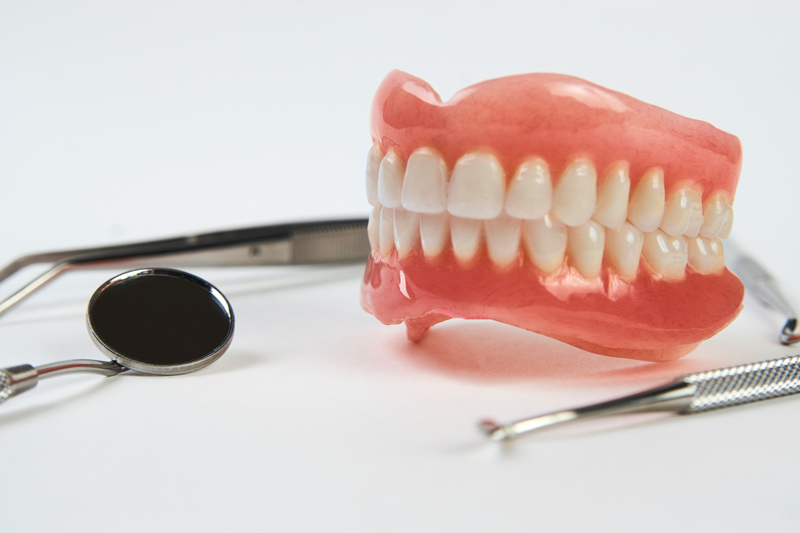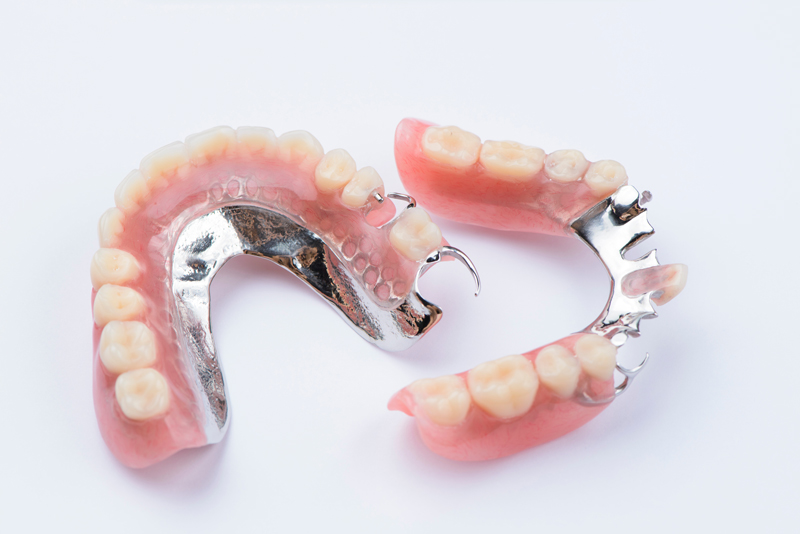Full and Partial Dentures
If you lost some or all of your natural teeth, dentures can replace your missing teeth. Dentures can be made to look like your natural teeth and can make eating and speaking easier. They can also support your cheeks and lips so facial muscles don’t sag.
Types of Dentures
There are several types of dentures available and different things to consider for each.
Conventional Complete Dentures have replacement teeth fitted into a plastic base. The base is made to closely match the color of your gums. Any natural teeth you may have will need to be removed before your dentures are placed.
- A conventional complete denture is made and placed in your mouth after any remaining teeth are taken out and the tissues have healed. Healing may take several months.
- In some cases, your dentist can make an immediate denture for you to wear during this healing period. This denture however will need relining after healing is complete in the mouth.
- The base of the upper denture covers the palate (roof of your mouth), resting against your gums and palate. Saliva helps create a tight seal to hold the denture in place.
- The lower denture has a horseshoe shape so there is room for your tongue and muscle attachments. It rests on the gum and bone tissues of your dental ridge.
- Conventional complete dentures can be put in and taken out as needed.

Implant-Supported Complete Dentures are attached to dental implants. Implant-supported dentures require that all your natural teeth be removed. If teeth are removed, your mouth will need to heal before this type of denture can be placed, which could take several months. In some cases, your dentist can make an immediate for you to wear during the healing period.
- Implant-supported dentures attach to metal stems that are surgically placed in our upper or lower jaw, and act like roots of natural teeth, supporting the dentures. The bone in your jaw will grow around the implant, which provides stability to the implant.
- Many people find that implant-supported dentures are more stable, comfortable, and secure than conventional dentures.
- Implant-supported dentures can be removable or fixed depending on what type is chosen.
Not everyone should get implants. This type of denture requires surgery, so you must be in good health and have enough bone to support the implants. Ask your dentist if you are a good candidate for dental implants.
Immediate Dentures may be an option for some people. These dentures are made before the remaining teeth are removed. Once the denture has been made, your dentist or oral surgeon removes your teeth, and the immediate denture is placed right away.
- With immediate dentures, you do not have to go without teeth during the healing time. Once healing is complete, the denture may need to be adjusted or relined. Sometimes a new denture needs to be made.
Partial Dentures
If you have missing teeth, a removable partial denture is one way to replace them.
These are a few of the advantages of a removable partial denture:
- It can be easier for you to chew food.
- You can speak better if your speech has changed due to missing teeth.
- Your cheeks and lips will be supported so your face does not sag and make you look older.

Other reasons to replace missing teeth
When you lose a tooth, the nearby teeth may tilt or drift into the empty space. The teeth in our other jaw may also shift into the space. This can affect your bite and place more stress and wear on your teeth and jaws. You may find it harder to clean teeth that have shifted, which can lead to tooth decay and gum disease. This is why it’s important to replace missing teeth.
How partial dentures work
A removable partial denture usually has replacement teeth attached to a metal or acrylic (plastic) base that matches the color of your gums. Partial dentures often have some form of clasp that attaches to your natural teeth and can easily be taken out of your mouth for cleaning or storing while you sleep.
Your dentist may also recommend crowns, or “caps,” on your natural teeth to improve the way a removable partial denture fits your mouth.
Reline and Repair
Denture Repairs
A variety of circumstances can lead to a damaged denture and should be addressed immediately. Repairs restore a fractured or damaged denture close to its original condition. Brafman Family Dentistry has a very competent dental laboratory that it works with to carry out its denture repairs.
Relining a denture
Relining is resurfacing the tissue side of a denture with a new material to fill the space that exists between the original denture contour and the altered tissue contour.
Relining of dentures is standard procedure for those patients that have their teeth extracted and the denture placed on the same day. When a tooth is extracted from its place within the alveolar bone tissue that houses it, the tissue undergoes what is known as resorption, or “breakdown” at the cellular level that takes its component materials and disperses them elsewhere throughout the body. In layman’s terms, this bony material is essentially “taken” back “into” the body for other use. Denture wearers experience most of this resorption within the first three to four months after extractions, then gradually over time throughout the rest of one’s life. As a result of this resorption, the gum tissue surrounding the alveolar bone experiences a change in density and shape that begins to cause a previously fitted denture to become more uncomfortable over time. This is where a denture reline can help.
Relining can also be used to repair a cracked denture and is an excellent way to delay the cost of a new denture altogether.
Hard relines to dentures must be sent to the laboratory and the patient will be without their denture for a few days.